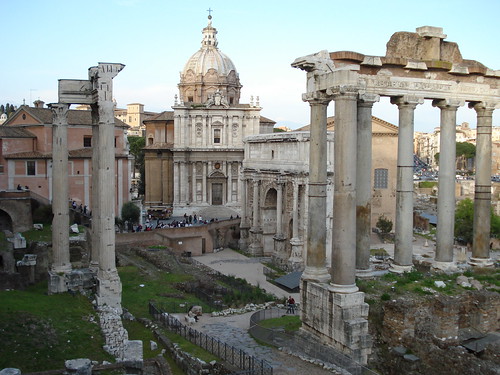 On Tuesday this week public offices in Rome shut down as the city celebrated the feast-day of two of its patron saints, Peter and Paul. So it was an appropriate time for Rome’s archaeological superintendency to announce some of the findings of an archaeological investigation at the Mamertine prison, in which Peter and Paul were allegedly imprisoned during the first century AD.
On Tuesday this week public offices in Rome shut down as the city celebrated the feast-day of two of its patron saints, Peter and Paul. So it was an appropriate time for Rome’s archaeological superintendency to announce some of the findings of an archaeological investigation at the Mamertine prison, in which Peter and Paul were allegedly imprisoned during the first century AD.
The recent excavation established that the Carcer Tullianum was the site of a religious cult from the fifth century BC, according to Dr Patrizia Fortini, an archaeologist from the Superintendency for Archaeological Heritage in Rome, who worked on the excavation.
She explained: We have confirmed the religious aspect of the site and also that this was linked to a water spring, traces of which have been found along with votive deposits from the sixth to the third centuries BC.
Dr Fortini added that the religious significance of the site during the sixth to the third centuries BC was note-worthy. The site was previously believed to have been a Roman cistern before it was used as a prison.
The site consists of a complex of chambers, some of which are integrated into the Campidoglio’s defensive walls. The earliest wall at the site dates from the eighth century BC. Two of the chambers, known as the Carcer and the Tullianam, are built one on top of the other, with the Carcer on top.
The Tullianum was already known to include a central circular structure, known as a ‘tholos’. The location of the water spring has been identified in the original flooring and the sacred nature of this is underlined by evidence of votive offerings (ceramic shards, fauna and burnt small animal bones).
Dr Fortini explained: When the republican walls were built next to the Capitoline slopes, the Tullianum would have been partly dismantled and incorporated into the complex of the prison.
She added: The sacred function of the site, connected to the spring water, continues into the Christian era and is associated with the cult of Saint Peter. This is supported by the discovery of a small stone basin in the Tullianum next to an archaic rectangular trough that the faithful would have used to sprinkle themselves with the water.
Sacred Frescoes
Dr Fortini said: “A series of frescoes in vibrant colours have also been restored and uncovered during the recent excavation and it’s a miracale that they have survived.”

The frescoes, dating from the 11th to the 14th centuries, were covered in a layer of calcium deposits and have been restored by the team working with Dr Fortini.
She describes the frescoes as a ‘palimpsest’ of religious images in three layers, which have been re-painted at various times in history.
Some of the images include a scene of Jesus with his hand resting on Saint Peter’s shoulder; a scene of the Madonna della Misericordia, or Virgin of Mercy, sheltering the faithful under her cloak; a scene of Saint Peter and Saint Paul; as well as a landscape view of the Capitoline hill, the Tabularium and a tower.
Other frescoes at the site include a representation of the hand of God or Jesus and an angel with a crown.
Was Saint Peter Jailed Here?
Some Christians believe that Peter was jailed at the Mamertine prison before being taken to the Vatican hill to be martyred in Nero’s Circus in 64 AD, the site of Saint Peter’s Basilica. The story goes that Peter converted and baptised his jailers Processus and Martinian, as well as 47 other prisoners, at the Mamertine prison.
Dr Fortini said: Our findings do not prove that Peter was held in the Mamertine prison. However, they support historical sources that refer to the presence at this site of the early church of San Pietro in Carcere. This church was built in 314 AD by Pope Silvester I.
Saint Peter’s Prison
According to Dr Fortini, enemies of the Roman state were held in the Tullian prison, while perpetrators of common crimes were held in the Lautomiae, an old quarry at the side of the Capitoline hill near the Mamertine prison.
The Mamertine prison is a multi-level site, comprising the upper chamber known as the Carcer, or prison, built in 640-616 BC by the fourth king of Rome, Ancus Marcius, and the lower Tullian chamber built in 578-534 BC by Rome’s sixth king, Servus Tullius.
A travertine faade was built on the structure in the middle of the first century AD, with a senatorial dedication from C. Vibius Rufio and M. Cocceius Nerva.
The circular Tullian chamber is about 7 metres in diameter and the Carcer is about 10 metres wide.
The church of San Giuseppe dei Falegnami (Saint Joseph of the Carpenters) was built on top of the site in the 16th century and below it is a chamber housing a holy crucifix.
The excavations were carried out by three organisations: the Sacred Art and Cultural Heritage of the Vicariate of Rome, the Superintendency for Archaeological Heritage in Rome and Opera Romana Pellegrinaggi.
Open to the Public
Whether the Mamertine prison was actually where Saint Peter was jailed or not, the 2,800 years of history and the restored frescoes make it nonetheless an interesting site to visit.
The Mamertine prison will open to the public in July. A series of guided tours and seminars are being organised at the site by Opera Romana Pellegrinaggi. Details of these will be posted here when they become available.
Photos by Soprintendenza Speciale per i Beni Archeologici di Roma and Romanus too from the Heritage Key Flickr pool.

